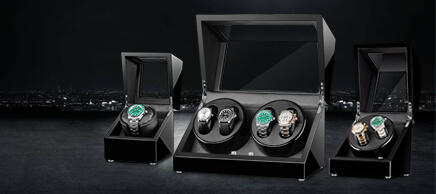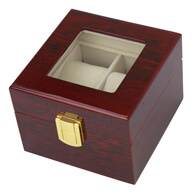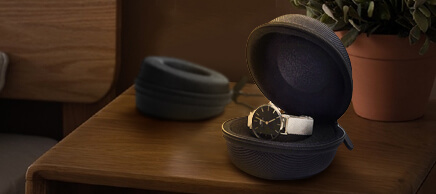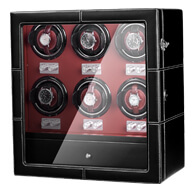How to Wind a Watch?
Contents
Mechanical watch
The difference between a manual watch and an automatic watch
How to wind a manual watch?
How to wind an automatic watch?
Watch winder
Conclusion
FAQS
Today, the value of a traditional mechanical watch is more than just a timekeeper, it has gone beyond its existence. The manufacturing process of mechanical watches is very complex and is a fine art, and many high-end watches have all components made by hand. After reading this article, you can learn how to wind your watch.
Mechanical watch
Mechanical watches rely on the winding of the watch movement to power the watch and do not require battery replacement. The mainspring is the part that provides energy and winds in a box. The mainspring winds using the milled square slot on the arbor. The winding mechanism drives the square slot of the bar.
The mechanical watch is different from the quartz watch in that the second hand of it is continuous and uninterrupted. The build quality and internal movement of a watch are susceptible to gravity, which can lead to errors. Usually, mechanical watches are calculated by the number of seconds of daily error, while quartz watches are calculated by the number of seconds of monthly error. With regular maintenance and oil washing, mechanical watches can last for a long time.
The difference between a manual watch and an automatic watch
Mechanical watches have two types: manual movement and automatic movement watches. The power source of both types of mechanical watches relies on the clockwork, which drives the gears to push the watch hand, but the ways of the power source are different.
A manual movement watch relies on the manual winding for power, and the thickness of the movement is thinner than that of an automatic movement watch, which makes it lighter in weight.
Automatic movement watches, on the other hand, use the automatic rotating disc of the movement to generate power to drive the winding, but the thickness of a manual movement watch is relatively smaller than that of an automatic movement watch.
How to wind a manual watch?
Place the watch on the table. Locate the stem that will be pulled out to wind the watch. The stem is a small dial on the side of the watch. Hold the watch face up. Use your thumb and index finger to carefully pull out the watch stem by the stem's top or crown. You should wind the watch clockwise until you feel resistance. Be cautious and don’t keep turning, once you feel resistance.
You can damage the watch if you continue to wind the stem past resistance. A manual winding watch does have a definite stopping point when winding. Don't rotate it too quickly so that you can stop it once it reaches the stopping spring. Press the crown to return the stem to its place. Never shove or force parts when handling the stem and crown of a watch.
How to wind an automatic watch?
If it is an automatic movement watch, the watch will operate for a long time. An automatic watch can be wound by movement, but the automatic movement will lose wind if you do not wear it regularly, then you need manual hand winding. An automatic movement is similar to a manual movement watch, except that it is powered by a rotor that maintains the watch's energy.
Just like a manual watch, you need to pull out the crown to expose the stem. Start by unthreading the crown by rotating it towards you. Once it is unthreaded, begin twisting the crown back and forth. This will wind the automatic movement. On an automatic watch, you cannot overwind it, so there will be no definite stopping point. The moving will continue to wind as long as you are winding the crown. Pull the crown out one-stop and set it to the correct date. Pull it out once more to change the time on the watch. Push the crown back in and thread forward until it stops. Once you wind the watch, you can set the time and other functions.
Another way to keep your automatic watch wound is by using a winder. The watch winder is essentially a watch box that spins and rotates your watch constantly, winding it in the process. In simple terms, an automatic watch winder is a box equipped with a motor and a microprocessor that is responsible for rotating the watch in a prescribed way. The winder mimics the movement of the wrist to move the watch. It is especially convenient if you own more than one automatic watch or have a watch with a high complication such as a perpetual calendar which is more complicated and takes extra time to set.

Watch winder
1. What is a watch winder?
A watch winder is a device used to keep automatic watches running when not worn. Automatic watches operate on the principle of winding themselves using a moving weight inside the watch. The weight swings or rotates while it is worn and turns the winding mechanism inside the watch. So, fairly obviously, If you are not wearing the watch, it no longer receives power this way and will run down. While we can manually wind almost all automatic watches, that is not always convenient. So the automatic watch winder was born.
2. Do you really need a watch winder?
If you only own 1-2 watches that you use regularly, you probably don't need a watch winder. If you have many watches in your collection, using a watch shaker would be a good choice. Automatic watches are intended for fairly regular wear. So concentrate your ownership of automatic watches on those that you will wear at least a couple of times a week. Winders are a great convenience for watches you don’t wear daily.
3. How to buy an appropriate watch winder?
A bad watch winder is worse than no winder. A poorly designed winder might cause undesirable wear of the watch’s mechanisms from excessive and repetitive movement. You need to pay attention to several values, such as TPD and the number of rotational turns. Exactly how long the winder rests is determined by the TPD setting. However, most automatic watches need somewhere between 650 and 950 TPD. JQUEEN provides you with excellent quality watch winders. We offer watch winders of various models and price points for you to choose from.
Conclusion
You can wind your watch in several ways as described above. If you have an automatic watch you seldom wear, simply wind it up every couple of weeks and let it run down. But for automatic watches, you wear frequently, but not continuously, a winder is a great solution for keeping them ready to wear at a moment's notice.
FAQS
1. How often does an automatic watch need to be wound?
After the watch is fully wound, the watch mechanical watch can generally run from 30 to 200 hours, basically, you only need to wind the watch once a day, the winding time is arbitrary, but it is best to choose the same time every day to wind the watch so that the watch time can be more accurate.
2. Is it possible to over-wind a mechanical watch?
No. All mechanical watches are equipped with a mechanism within the movement that disengages the winding gear from the mainspring once it is fully wound.
3. Will often manually winding a self-winding watch affect the movement?
Automatic watches are often wound manually, which accelerates wear and tear. Once the mechanism wears out and fails to be repaired in time, the wear and tear will increase rapidly, especially for the winding and hand-winding parts. Watches with a large number of core diamonds may be relatively good, but it is best not to wind them manually often.
4. Does watch winder harm your watch?
Today most winders are equipped with a security program that ensures they can never over-wind a timepiece. There is no significant evidence that a good watch winder will either save or harm your watch.
5. How many watch winder settings for rolex?
Rolex watches usually require about 650-800 TPD (revolutions per day) to maintain 100% of the kinetic energy of the day. The vast majority of Rolex watches are bidirectional, which means you can wind it clockwise or counterclockwise.
Thank you for reading.









Congratulations, you have completed Facebook authorization.
To finish the login process, please provide email address.